Read Part I here
We sit sipping tea and eating surprisingly good chocolate croissants as the sun sets over the Naga hills. All around us are acres of tea estates, waves of short green shrubs punctuated by the occasional tree; the first we have seen in Nagaland. We are outside the village of Shiyong, at the Konyak Tea Retreat run by the lively and immensely likeable Phejin Konyak. The place is beautiful, her home warm and welcoming, the surroundings serene and we decide to stay a day longer. Plus we still had lots to talk about. Phejin, a Konyak herself, like many young Nagas today has lived most of her formative years outside the state. However after completing a course in design from NIFT, leading the typical agency life in a metro did not quite catch her fancy; she yearned to return to the hills of her home. On returning to Shiyong, with time on her hands and a wandering mind, she started travelling, armed with a backpack and camera, from village to village. She sought to understand better her own people and reconnect with her roots, documenting her impressions, thoughts and stories along the way. After two years of wandering the villages around the Mon region, many of which are still only accessible by foot, Phejin started formalizing what she learnt and began working on a book with Dutch photographer, Peter Bos. She is an expert on Konyak history and heritage, especially on the art and stories behind the culture of tattoos.
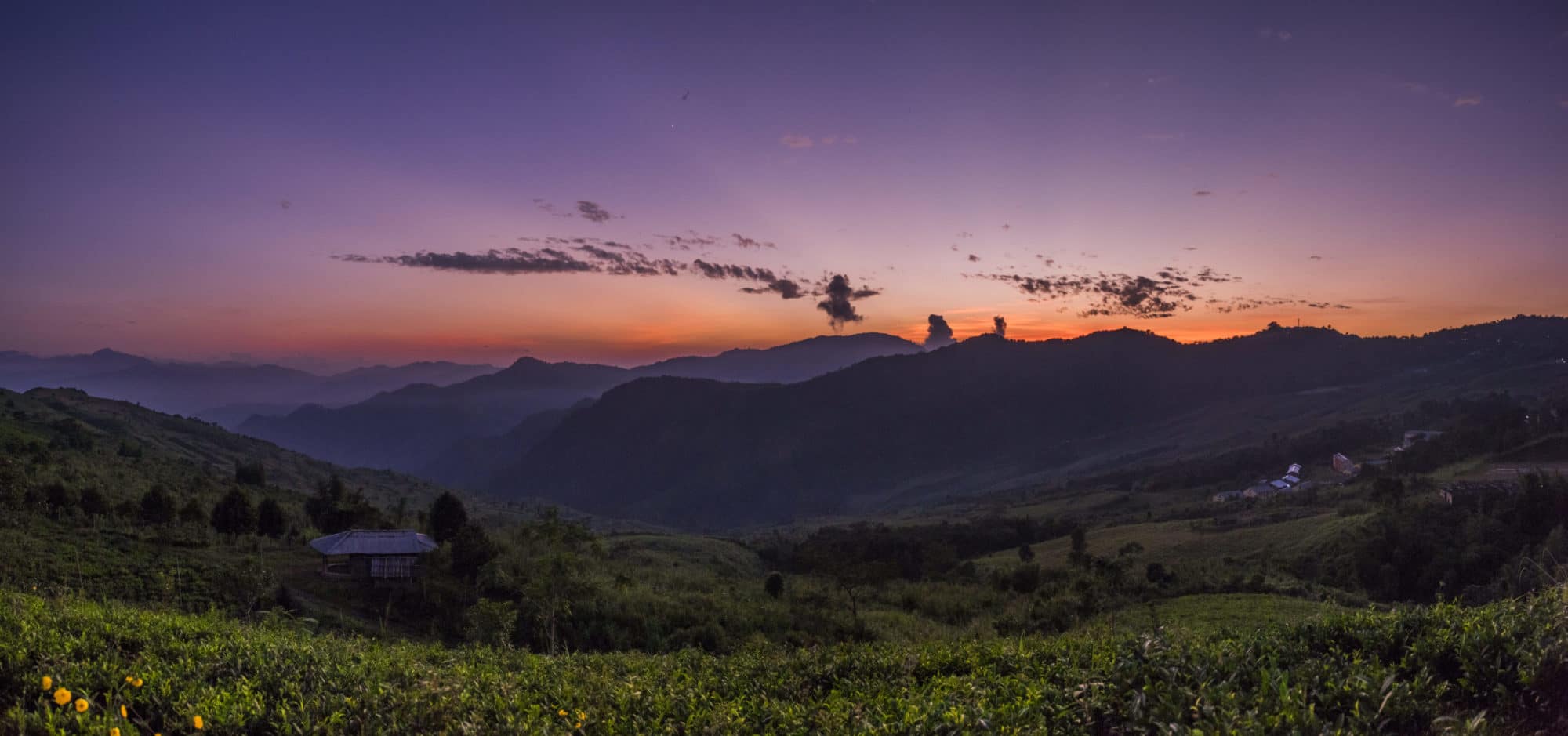
‘The croissants are from a packet smiles’, Phejin when we ask her for another, ‘you can get them at the market for ten rupees. They come from Calcutta’. We are beyond excited, after weeks of a largely rice diet, we yearn for bread and other carbs. As we slowly work through her box of croissants, Phejin launches off into yet another story of an adventure in Konyak heartland and the subtle differences between tattoos, while she deftly whips up what promises to be another excellent meal. In between exchanging stories and conversation, she has introduced us to Konyak food, including a different style of pork curry, beef chutney, a dried fish and eggplant mix, a mild gravy made of taro, and local rice beer.
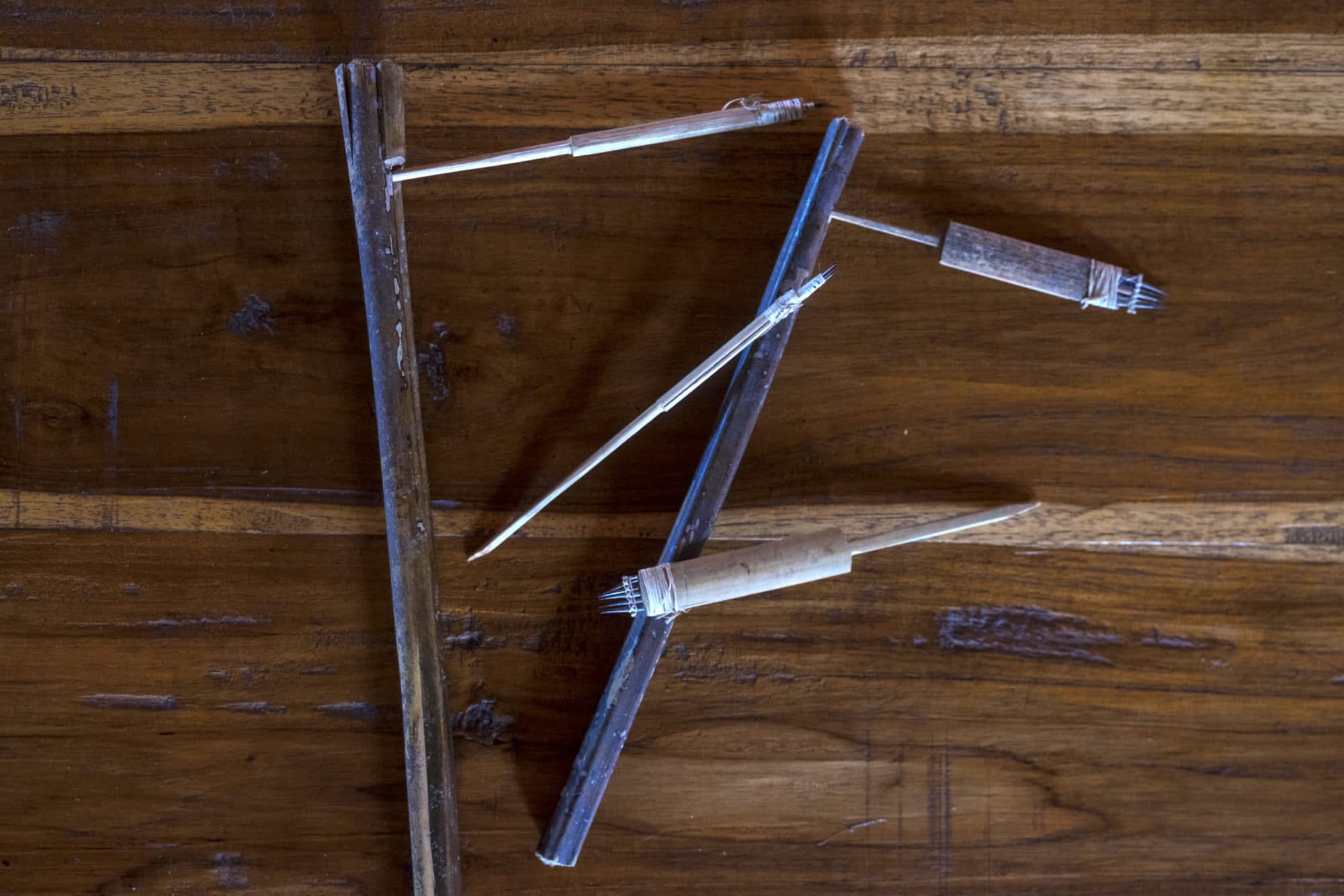
There are many types of facial tattoos. The designs change, from villages in the north to the ones in the east. They are closely linked to the dialects spoken by the various sub tribes of the Konyaks which also change from village to village. ‘Some tribes have chest and back tattoos, some have leg tattoos, others don’t,’ she explains, whilst showing us rudimentary replicas of the tools used by the Konyak tattoo artists, who is always the Queen of the village. People consider headhunting barbaric but it is important to understand that it wasn’t random acts of violence. According to old Naga animist beliefs, the head was considered to be a source of life and energy; taking the head, it was believed, would lead to good harvests and the welfare of the village. Battle was waged over land disputes and in some cases to assert independence or grow the tribe, not unlike empires and kingdoms of the past. Contrary to popular belief, the facial tattoos, Phejin clarifies, does not necessarily mean a warrior has taken a head, it usually denotes participation in battle. As do the tattoos on other parts of the body. A neck tattoo on the other hand is the mark of a true headhunter, the ones who return with a human skull. As per tradition, when the warriors return from a successful battle they are tattooed by the Queen of the village, the first wife of the Angh, the village chief. Phejin proudly shows off her own forearm tattoo made using traditional ink and implements, by one of the last surviving Konyak Queens. The old Queen hadn’t made one in years, and this will probably be the last one she ever makes.
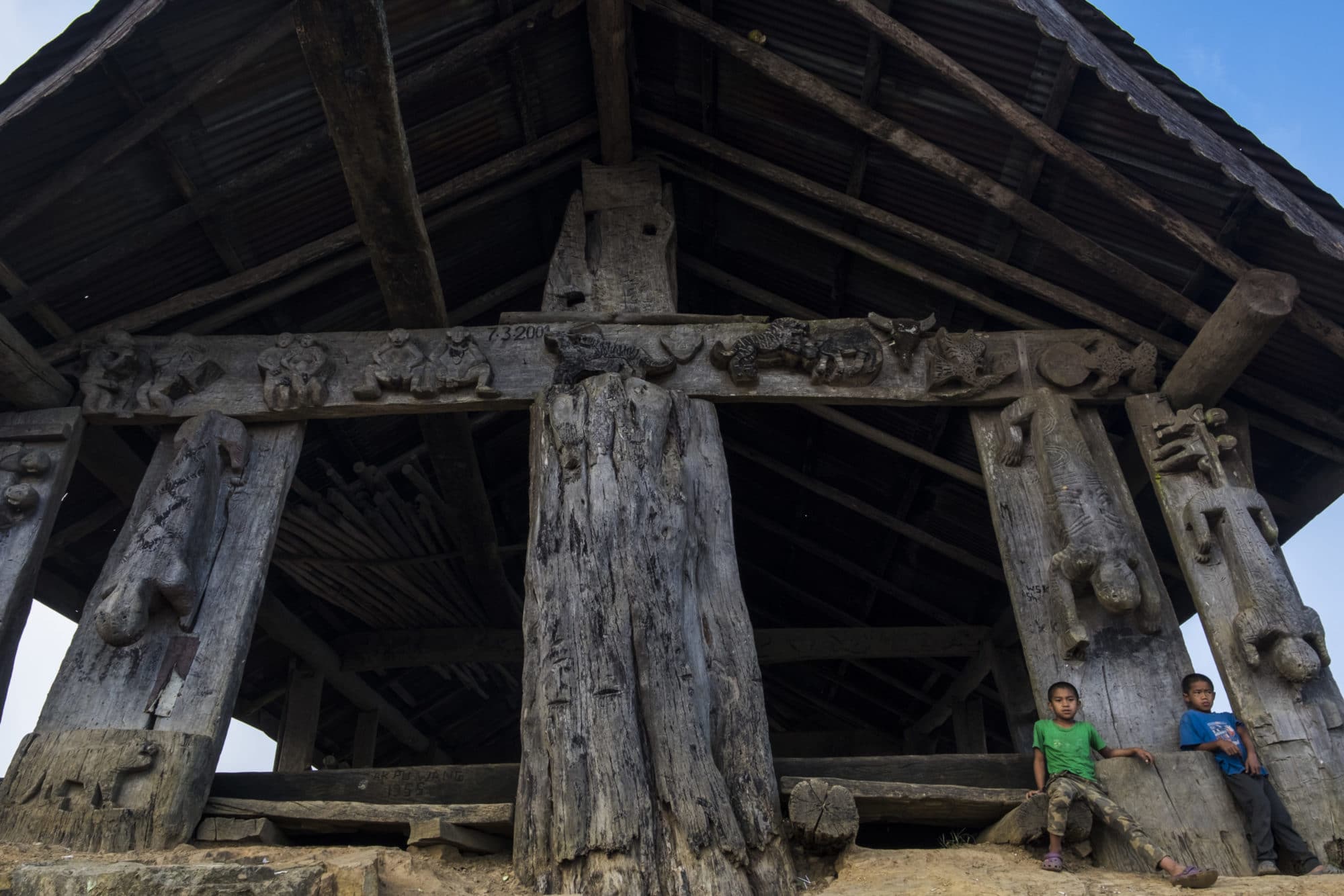
Our last stop was Hongpoi, a small hamlet about an hour away from the main town of Mon. After wandering through Shiyong, Wakching and other villages, we have left Hongpoi till the end; it is home to the last tattooed Angh in the region. Atleast one that is easily accessible. We are here on a Sunday afternoon, at our guide Nahmei’s suggestion. The village is quiet, the choir is practicing in the church and the women have gathered to share a light moment. We meet some of these women as we walk around the village, and chat about our travels, their lives and the local school. One of them is a school teacher.
Sunday is also the day the older men in the village collect in the Morung, the traditional Naga male ‘hostel’ along with the Angh, to talk over cups of steaming red tea. Smaller than other villages we had been to, Hongpoi is no different from the rest of the state. People are warm and smiling, the village is clean and green. Whatever the stories about fierce Naga headhunters, the people we met all over Nagaland were nothing short of kind, joyous and friendly. The Morung in Hongpoi is a more recent structure, rebuilt using funds provided under the National Rural Employment Guarantee scheme. Unlike others in Nagaland, which are largely ceremonial, this one seemed to be in use.
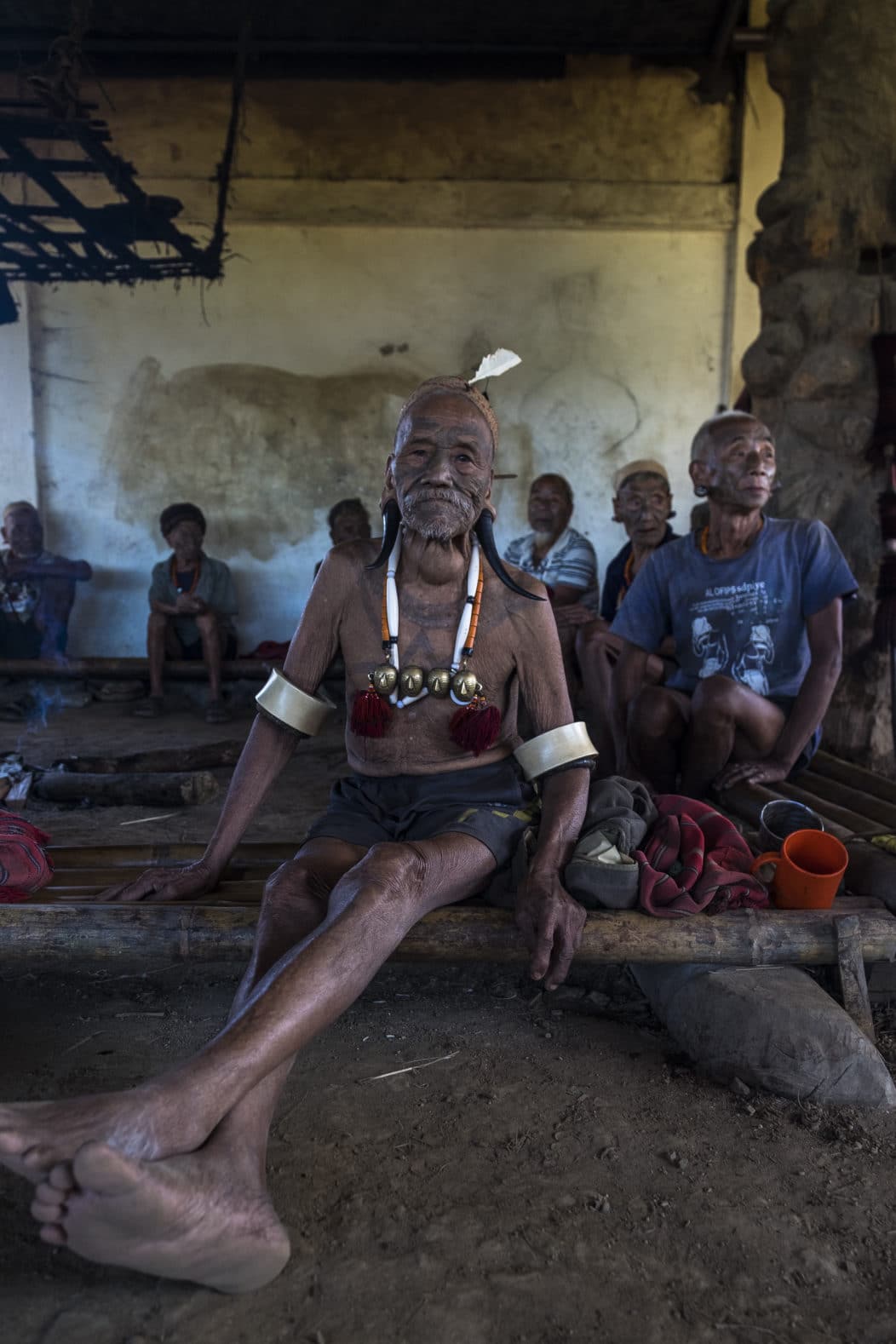
We entered the Morung and taking Nahmei’s lead, we respectfully greeted the Angh first. Even after spending 3 weeks in Nagaland and experiencing everything from the beautiful to the bizarre, the scene that confronted us was surreal. It was almost as if we had stepped into a different world, one that was slowly opening itself to us. Around a fire where a charred kettle of tea sat boiling were at least 10 – 12 tattooed headhunters. They were a motley bunch, all between 80 and 95. Some of them, bare-chested, sporting beads and brass necklaces. One wore a hat made of wildcat skin, another a headband with a bird feather and a thick armband made of bone. The Angh himself wore a hat mounted with boar tusks. All of them had tattoos either on the chest or face, some of them on both, yet others on the hands or arms. All of them were chewing the beetle nut that is staple in the state.
We notice the designs, subtly different from ones we had seen in Lungwa, denoting the difference in sub-tribes and across villages. Many of the tattoos are detailed and intricate, time and patience has gone into creating a form of art. The Angh welcomes us to sit with him and the other villagers. Unlike some of the other chiefs we have met, he is friendly and conversational, proud of his responsibility of being the chief, which he inherited from his father when he was 50. He is now 85, and more interested in life in the Morung. ‘Life is better now,’ he tells us, and ‘there is peace and no violence. We have more freedom to move about between villages’. He wears the traditional blue beads that the chiefs family wears and admits that he hadn’t taken a life during battle. We take a few photos whilst taking to the old men, and Nahmei translates – he struggles a bit, he is a Konyak from Lungwa. The dialect here is different in Hongpoi, despite the villages being less that 150 km apart.
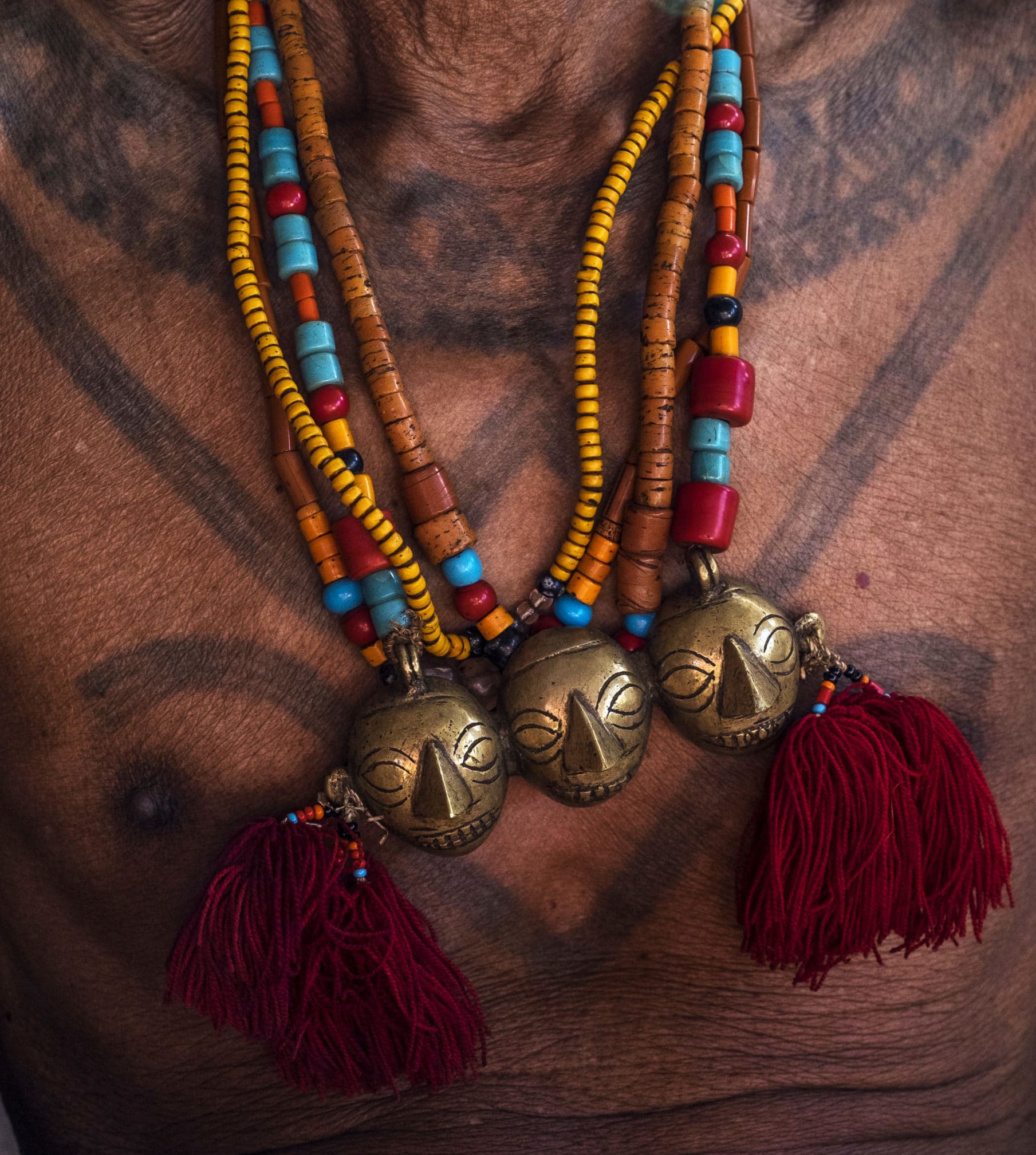
Over cups of tea we learn that Hongpoi is one of the last villages in Mon to give up the practice of tattooing and in some ways have managed to hold on their traditions a little longer. ‘Doesn’t it hurt?’ we ask an old man with extensive tattoos, it was a question we had asked others before. ‘Yes it did,’ he answers, and adds, with a twinkle in his eye, ‘but it gave us a certain status in the village, especially among the women!’ We all laugh, it is an honest admission by an old man. Don’t they tire, we wonder, as we prepare to leave after much conversation, laughter, antics and tea, of the constant intrusion in their life, the questions and cameras, the people who come from all over the world poking and prodding. Nahmei puts the question to the Angh, who pauses before answering. “We are happy to meet people from everywhere and tell them about our lives,’ he says, ‘we are glad they come and are interested in learning about our traditions. We only hope that they understand us, and are respectful.’
Some Useful Information:
How to get there: Mon district is home to the Konyak tribes of Nagaland and the famous tattooed headhunters. Mon town is the main center of Mon district and can be reached by shared sumo from Sonari in Assam.
The closest airport to Mon is Dibrugarh which is about 5 – 6 hours away.
Where to Stay: The best place to stay in Mon is Helsa Cottage, less than a 10 minute walk from the main sumo and bus stand. Rooms start at Rs 1000/- for a double and has excellent homemade food on offer.
Village Visits and Stays: From Mon Town you can travel to the various villages spread across the region to meet the tattooed headhunters. Chief amongst these are Lungwa, Hongpoi and Mon village. Shared sumos and buses are available, but make sure you check timings since there are usually only one or two modes of transport a day to these villages, and none on Sundays.
Homestays are available in many of these villages and the good folks at Eastern Routes can help you out with this. They can also help you organise your entire Mon / Nagaland trip.
If you want to spend a relaxing few days surrounded by beautiful tea gardens while eating authentic Konyak food and learning more about the culture we suggest you stay a couple of days at the Konyak Tea Retreat in Shiyong Village. Highly Recommended.
If you do visit a village make sure to get yourself a good guide, without which it will be difficult to interact with the villagers, enter their homes and understand their culture better. Nahmei or Anyam, are both registered local guides who know their stuff and are a storehouse of information. Get in touch with us if you need their contact.
Its so beautifully written..I am planning a trip to Mon, lungwa and one night at the Konyak Tea Estate..could you help me out with how to reach Konyak Tea Estate from Mon. Thanks. Also could you help me with contact number for the Tea Estate
Thanks so much Upasana! That region of Nagaland Is special. If you do make a trip down to the Tea estate would suggest you spend atleast a couple of days. The place is beautiful and the journey there rough, so don’t think you will want to leave in a day. Suggest you write to them, the website should have an email address.